中国全科医学 ›› 2022, Vol. 25 ›› Issue (24): 2975-2983.DOI: 10.12114/j.issn.1007-9572.2022.0120
所属专题: 高血压最新文章合辑
喜杨1, 孙宁玲1,*( ), 曾哲淳2, 王锦纹2, 苏江莲2
), 曾哲淳2, 王锦纹2, 苏江莲2
收稿日期:2022-02-25
修回日期:2022-03-09
出版日期:2022-08-20
发布日期:2022-06-30
通讯作者:
孙宁玲
Yang XI1, Ningling SUN1,*( ), Zhechun ZENG2, Jinwen WANG2, Jianglian SU2
), Zhechun ZENG2, Jinwen WANG2, Jianglian SU2
Received:2022-02-25
Revised:2022-03-09
Published:2022-08-20
Online:2022-06-30
Contact:
Ningling SUN
About author:摘要: 背景 新型冠状病毒肺炎(COVID-19)疫情期间,部分高血压患者需进行居家医学观察,但其血压、心率(HR)等数据变化特点及血压管理情况尚不明确。 目的 分析居家医学观察高血压患者的血压、HR及测量频率的变化特点。 方法 通过iHealth云平台收集武汉市2019-12-01至2020-03-27所有通过iHealth BPM1型全自动智能血压计上传家庭血压测量数据并拥有连续血压值记录的ID号的高血压患者数据〔包括年龄、性别、收缩压(SBP)、舒张压(DBP)、HR〕,并对其进行脱敏和敏感信息消除。结合相关数据,分析居家医学观察高血压患者的血压特点,采用ARIMAX多元回归评估年龄、性别、每日新发病例数、累计死亡数、不同时间粒度和交通管制等对患者血压、HR的影响。 结果 共1 232台血压表在118 d内记录了36 472次血压数据,男性平均SBP、平均DBP、平均HR均高于女性(P<0.05)。2020-01-23后,高血压患者的平均SBP由(141±19)mm Hg下降到(138±18)mm Hg(P<0.05)。通过ARIMAX多元回归调整月、周及年龄、每日新发病例数后发现,2020-01-23后居家医学观察男性高血压患者血压下降(βSBP=-1.08×10-3,P=0.028,βDBP=-6.35×10-4,P=0.002),平均HR(βHR=2.02,P=0.003)、血压测量频率(β次数=0.035,P=0.002)升高;交通管制后居家医学观察女性高血压患者血压、平均HR、血压测量频率变化不明显(P<0.05)。 结论 居家医学观察的男性高血压患者血压、HR和血压测量频率均高于居家医学观察的女性高血压患者,交通管制后居家医学观察高血压患者平均SBP下降。利用互联网平台,高血压患者通过可传输的家庭血压测量设备进行血压测量及数据的评估和处理,能够更好地进行院外自我血压管理,体现出"互联网+医疗健康"的重要价值。
| 项目 | 性别 | SBP(mm Hg) | DBP(mm Hg) | HR(次/min) |
|---|---|---|---|---|
| 以月为时间粒度 | 男 | 140±19a | 89±12a | 73±12a |
| 女 | 137±18 | 83±11 | 71±11 | |
| 以日为时间粒度 | 男 | 140±19a | 89±12a | 73±12a |
| 女 | 137±18 | 83±11 | 71±11 | |
| 以每日不同时段为时间粒度 | 男 | 140±19a | 89±12a | 73±12a |
| 女 | 137±14 | 83±11 | 71±11 |
表1 不同时间粒度下男性、女性平均SBP、DBP和HR比较(±s)
Table 1 Comparison of mean systolic blood pressure,diastolic blood pressure and heart rate at different time granularities between male and female hypertensive patients quarantined at home
| 项目 | 性别 | SBP(mm Hg) | DBP(mm Hg) | HR(次/min) |
|---|---|---|---|---|
| 以月为时间粒度 | 男 | 140±19a | 89±12a | 73±12a |
| 女 | 137±18 | 83±11 | 71±11 | |
| 以日为时间粒度 | 男 | 140±19a | 89±12a | 73±12a |
| 女 | 137±18 | 83±11 | 71±11 | |
| 以每日不同时段为时间粒度 | 男 | 140±19a | 89±12a | 73±12a |
| 女 | 137±14 | 83±11 | 71±11 |
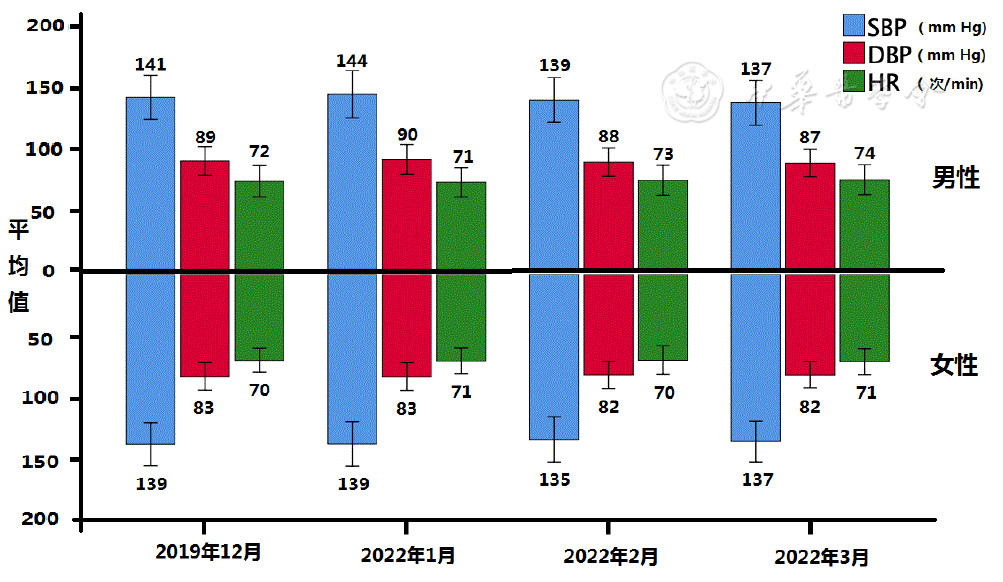
图1 不同月份男性、女性平均SBP、DBP和HR比较注:SBP=收缩压,DBP=舒张压,HR=心率
Figure 1 Comparison of mean systolic blood pressure,diastolic blood pressure and heart rate between male and female hypertensive patients quarantined at home by month
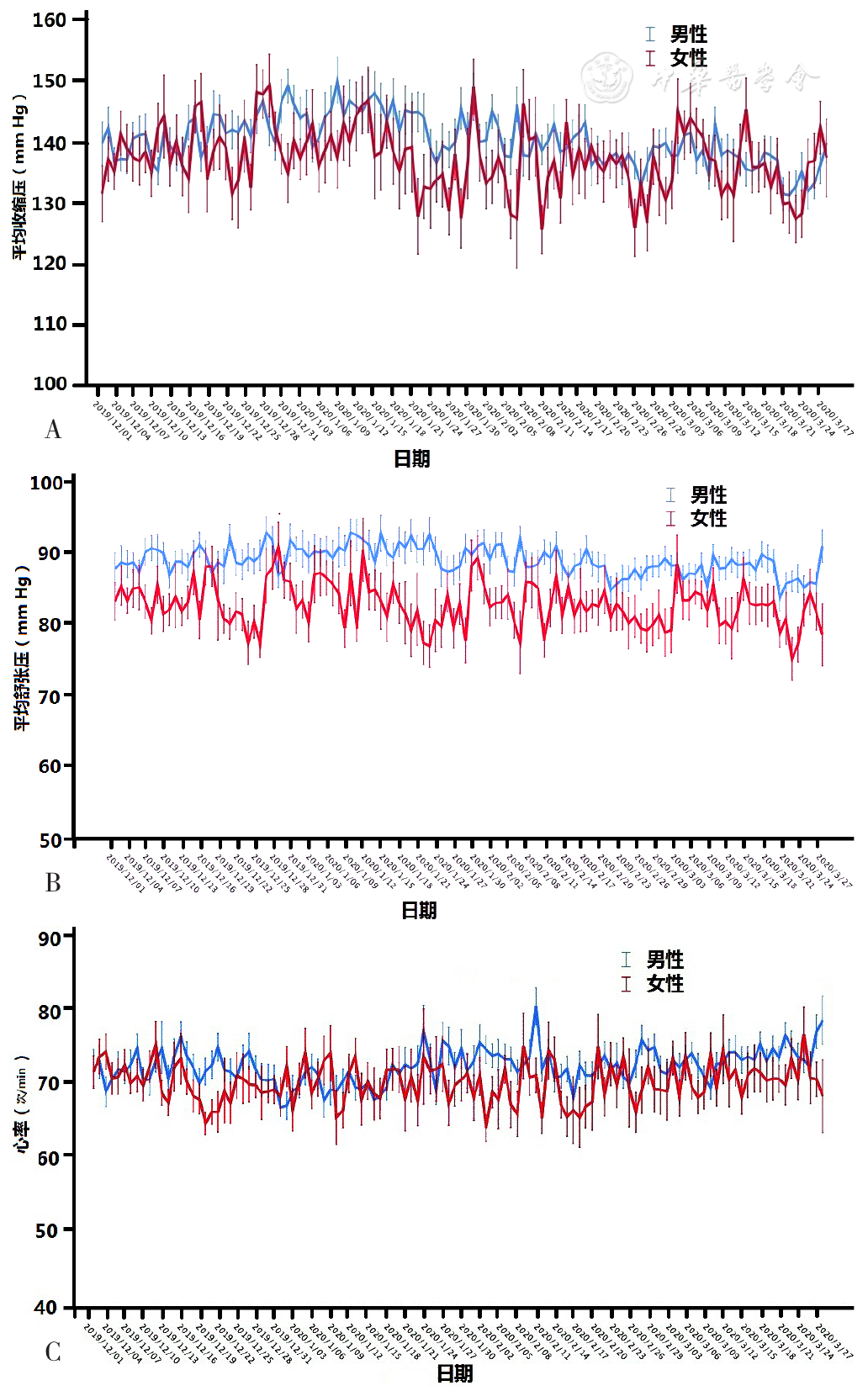
图2 118 d中每日SBP、DBP、HR在男性和女性中的比较注:A表示每日平均SBP,B表示每日平均DBP,C表示每日平均HR
Figure 2 Comparison of mean daily systolic blood pressure,diastolic blood pressure and heart rate in male and female hypertensive patients quarantined at home during the 118-day period
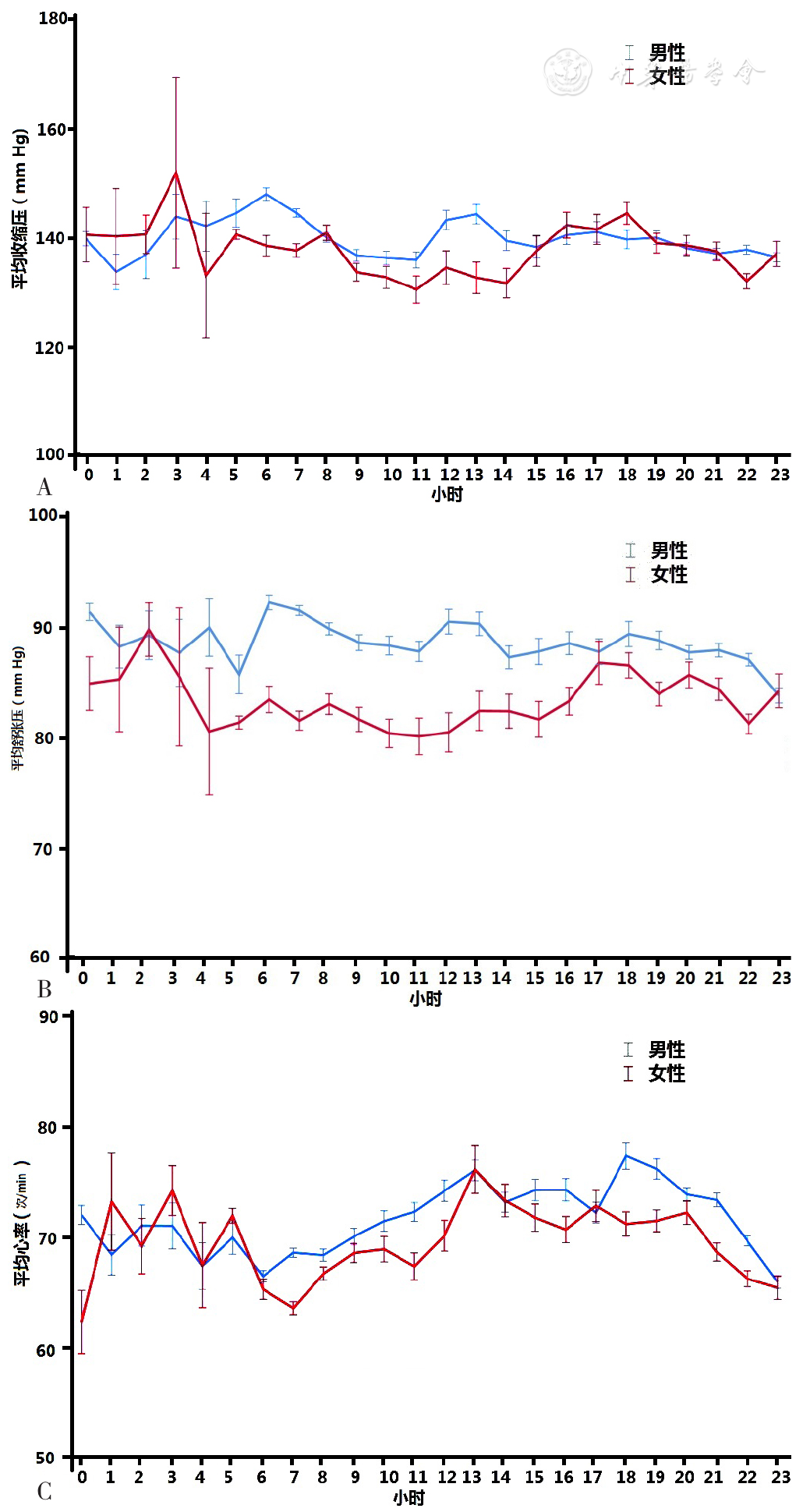
图3 每日不同时段男、女性平均SBP、平均DBP及平均HR比较注:A表示每日不同时段平均SBP,B表示男每日不同时段平均DBP,C表示每日不同时段平均HR
Figure 3 Comparison of mean systolic blood pressure,diastolic blood pressure and heart rate at different time granularities per day between male and female hypertensive patients quarantined at home
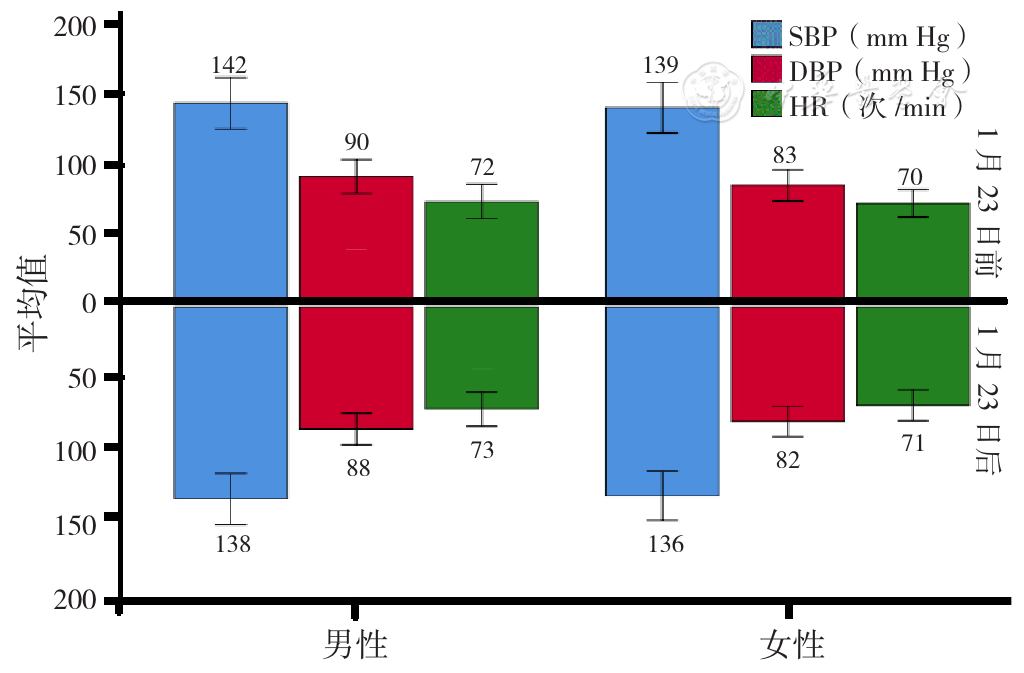
图4 交通管制前(2020-01-23之前)、后(2020-01-23之后)男、女性高血压患者血压、HR
Figure 4 Mean systolic blood pressure,diastolic blood pressure and heart rate in male and female hypertensive patients quarantined at home before and after the traffic control implemented on January 23,2020
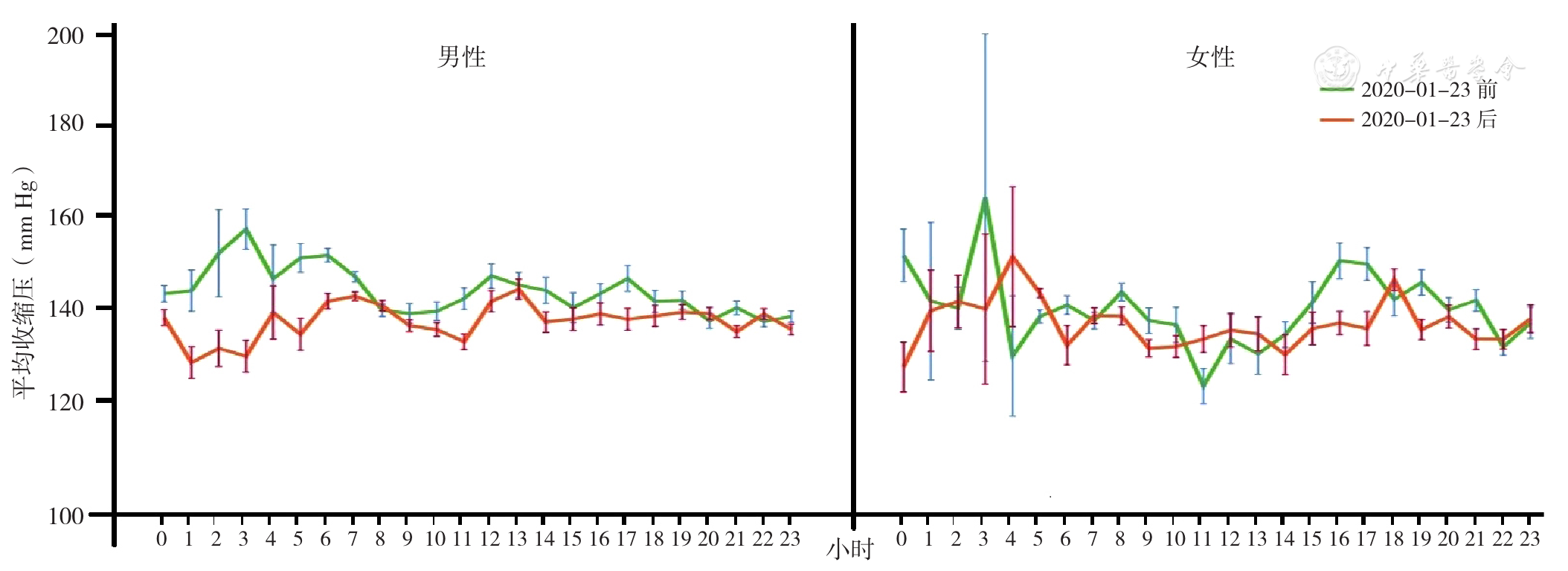
图5 交通管制前后男性和女性的SBP变化
Figure 5 Mean systolic blood pressure in male and female hypertensive patients quarantined at home before and after the traffic control
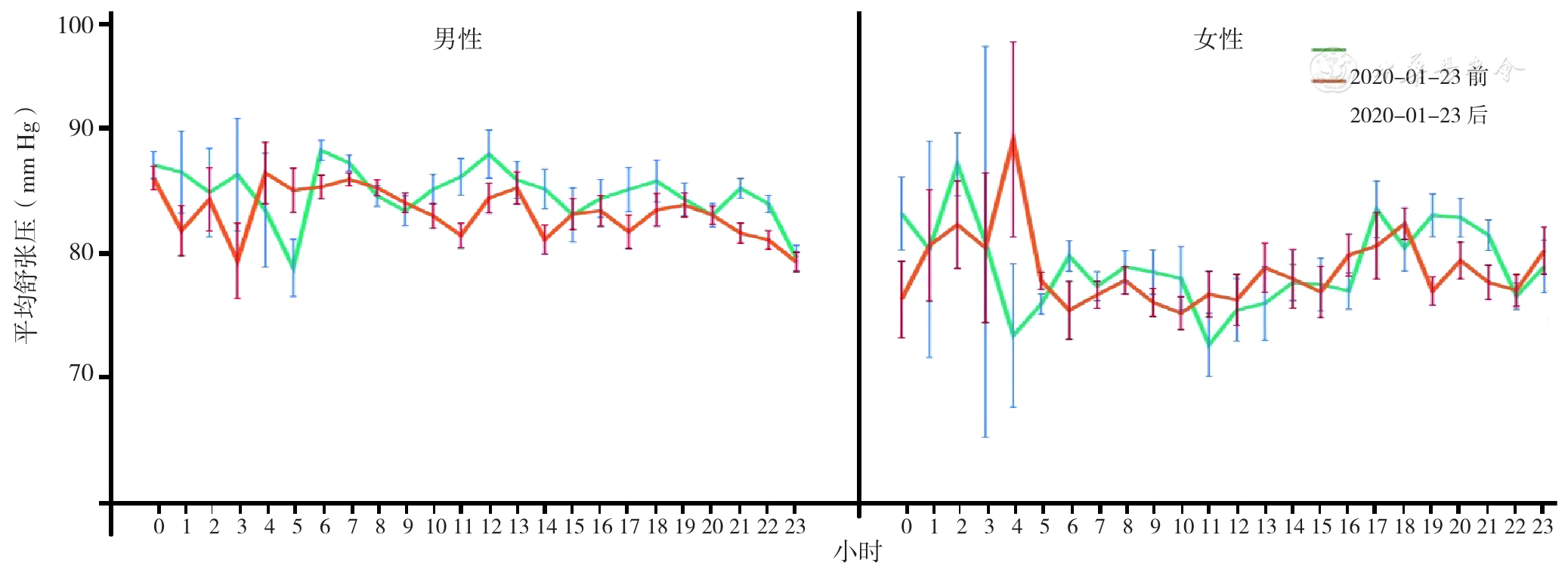
图6 交通管制前后男性和女性的DBP变化
Figure 6 Mean diastolic blood pressure in male and female hypertensive patients quarantined at home before and after the traffic control
| 性别 | 日期 | SBP(mm Hg) | DBP(mm Hg) | HR(次/min) |
|---|---|---|---|---|
| 男 | 1月23日前 | 142±19 | 90±12 | 72±12 |
| 1月23日后 | 138±18 | 88±11 | 73±12 | |
| 女 | 1月23日前 | 139±18 | 83±11 | 70±10 |
| 1月23日后 | 136±18 | 82±11 | 71±11 |
表2 交通管制前后不同性别高血压患者的血压及HR变化(±s)
Table 2 Changes of mean systolic blood pressure,diastolic blood pressure and heart rate in male and female hypertensive patients quarantined at home before and after the traffic control
| 性别 | 日期 | SBP(mm Hg) | DBP(mm Hg) | HR(次/min) |
|---|---|---|---|---|
| 男 | 1月23日前 | 142±19 | 90±12 | 72±12 |
| 1月23日后 | 138±18 | 88±11 | 73±12 | |
| 女 | 1月23日前 | 139±18 | 83±11 | 70±10 |
| 1月23日后 | 136±18 | 82±11 | 71±11 |
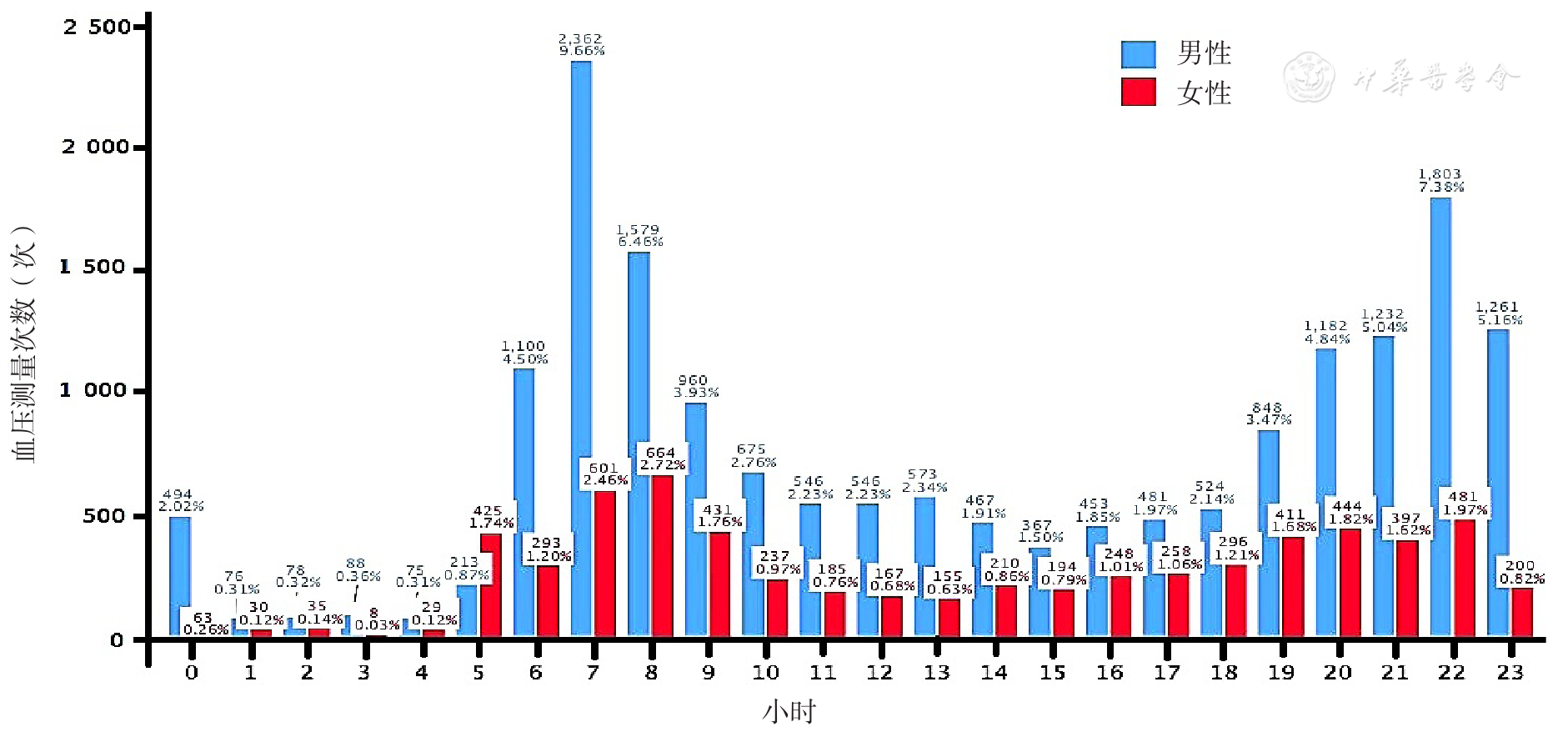
图8 一日内不同时段男、女血压测量次数的分布
Figure 8 Distribution of blood pressure measurement frequency at different time granularities per day in male and female hypertensive patients quarantined at home
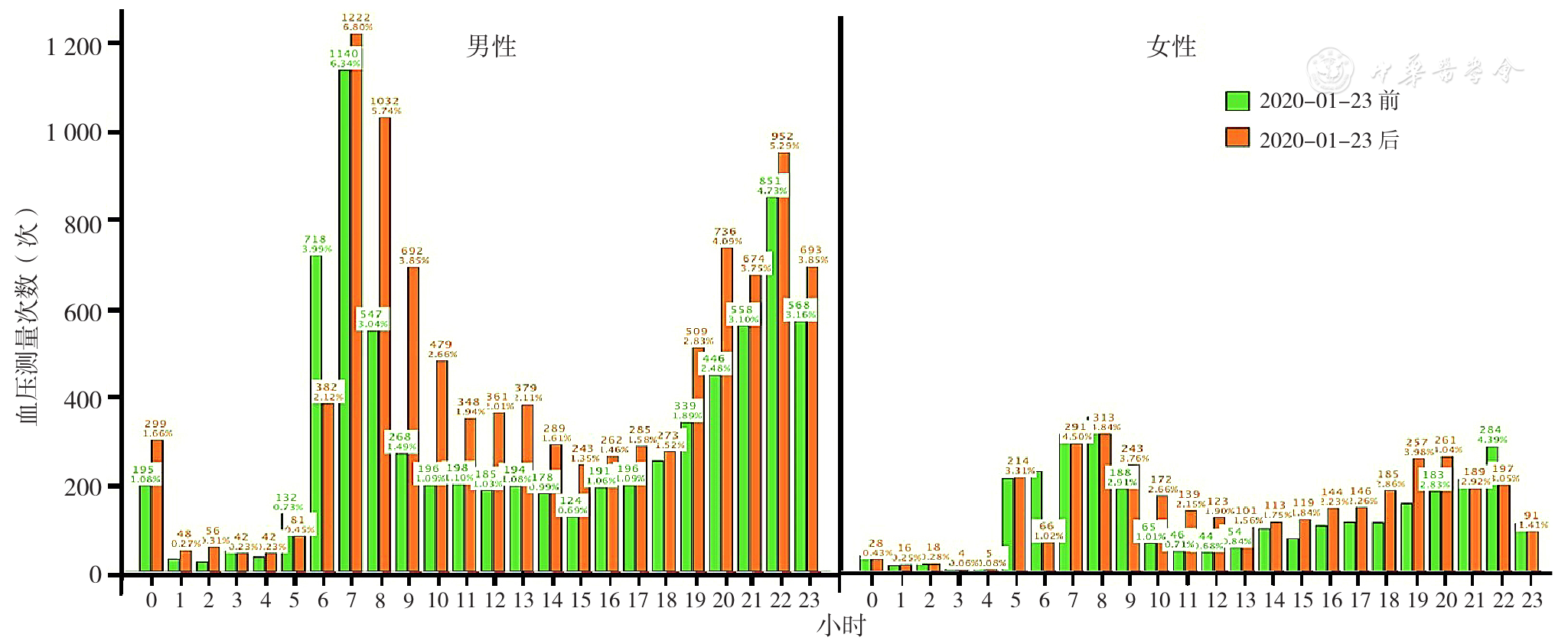
图9 交通管制前后男、女性一日内不同时段血压测量次数比较
Figure 9 Comparison of blood pressure measurement frequency at different time granularities per day in male and female hypertensive patients quarantined at home before and after the traffic control
| 时间 | 例数 | 男 | 女 |
|---|---|---|---|
| 2020-01-23前 | 10 631 | 7 604(71.5) | 3 027(28.5) |
| 2020-01-23后 | 13 814 | 10 379(75.1) | 3 435(24.9) |
| 合计 | 24 445 | 17 983(73.6) | 6 462(26.4) |
表3 交通管制前后男、女血压测量次数〔n(%)〕
Table 3 Blood pressure measurement times in male and female hypertensive patients quarantined at home before and after the traffic control
| 时间 | 例数 | 男 | 女 |
|---|---|---|---|
| 2020-01-23前 | 10 631 | 7 604(71.5) | 3 027(28.5) |
| 2020-01-23后 | 13 814 | 10 379(75.1) | 3 435(24.9) |
| 合计 | 24 445 | 17 983(73.6) | 6 462(26.4) |
| 自变量 | 因变量 | 回归系数 | 标准误 | Z值 | 95%CI | P值 |
|---|---|---|---|---|---|---|
| 年龄 | SBP | 2.02×10-1 | 1.09×10-1 | 1.84 | (-1.30×10-2,4.16×10-1) | 0.066 |
| DBP | -3.32×10-3 | 5.24×10-2 | -0.06 | (-1.06×10-1,9.95×10-2) | 0.949 | |
| HR | -5.79×10-2 | 6.23×10-2 | -0.93 | (-1.80×10-1,6.42×10-2) | 0.353 | |
| 累计死亡数 | SBP | -1.08×10-3 | 4.92×10-4 | -2.20 | (-1.16×10-4,-2.04×10-3) | 0.028 |
| DBP | -6.35×10-4 | 2.68×10-4 | -2.37 | (-1.10×10-4,-1.16×10-3) | 0.018 | |
| HR | -3.25×10-4 | 2.65×10-4 | -1.23 | (-8.44×10-4,1.93×10-4) | 0.219 | |
| 每日新发病例数 | SBP | -2.23×10-4 | 5.31×10-4 | -0.42 | (-1.26×10-3,8.17×10-4) | 0.674 |
| DBP | -3.52×10-5 | 3.34×10-4 | -0.11 | (-6.91×10-4,6.20×10-4) | 0.916 | |
| HR | 2.53×10-4 | 2.12×10-4 | 1.20 | (-1.62×10-4,6.68×10-4) | 0.232 | |
| 以月为时间粒度 | SBP | -1.46×10-1 | 9.12×10-2 | -1.61 | (-3.25×10-1,3.22×10-2) | 0.108 |
| DBP | -1.12×10-1 | 4.68×10-2 | -2.38 | (-1.98×10-2,-2.03×10-1) | 0.017 | |
| HR | 4.75×10-2 | 6.39×10-2 | 0.74 | (-7.79×10-2,1.73×10-1) | 0.458 | |
| 以周为时间粒度 | SBP | 2.15×10-2 | 3.36×10-2 | 0.64 | (-4.44×10-2,8.74×10-2) | 0.523 |
| DBP | 1.67×10-2 | 1.93×10-2 | 0.86 | (-2.12×10-2,5.46×10-2) | 0.388 | |
| HR | 1.43×10-2 | 2.23×10-2 | 0.64 | (-2.94×10-2,5.80×10-2) | 0.522 | |
| 以每日不同时段为时间粒度 | SBP | 4.64×10-2 | 1.10×10-1 | 0.42 | (-1.70×10-1,2.62×10-1) | 0.674 |
| DBP | 6.85×10-2 | 6.51×10-2 | 1.05 | (-5.91×10-2,1.96×10-1) | 0.293 | |
| HR | -2.55×10-2 | 5.50×10-2 | -0.46 | (-1.33×10-1,8.22×10-2) | 0.642 | |
| 交通管制 | SBP | -1.65 | 1.27 | -1.30 | (-4.14,8.37×10-1) | 0.193 |
| DBP | -6.38×10-1 | 7.60×10-1 | -0.84 | (-2.13,8.52×10-1) | 0.401 | |
| HR | 2.02 | 6.85×10-1 | 2.94 | (6.72×10-1,3.36) | 0.003 | |
| 常数 | SBP | 1.30×102 | 5.98 | 21.68 | (1.18×102,1.41×102) | <0.001 |
| DBP | 8.79×10 | 2.98 | 29.52 | (8.21×10,9.38×10) | <0.001 | |
| HR | 7.37×10 | 3.48 | 21.20 | (6.69×10,8.05×10) | <0.001 | |
| ARMA模型 | ||||||
| ar L1 | SBP | 3.39×10-1 | 9.00×10-2 | 3.76 | (1.62×10-1,5.15×10-1) | <0.001 |
| DBP | 2.16×10-1 | 9.51×10-2 | 2.27 | (2.95×10-2,4.02×10-1 | 0.023 | |
| HR | 4.07×10-1 | 9.39×10-2 | 4.33 | (2.23×10-1,5.91×10-1) | <0.001 | |
| ARIMAX模型 | SBP | 最大似然估计=-257.195 2,χ2=56.77,P=0.000 1 | ||||
| DBP | 最大似然估计=-187.936 9,χ2=42.67,P=0.000 1 | |||||
| HR | 最大似然估计=-192.956 1,χ2=31.27,P=0.000 1 | |||||
表4 SBP、DBP、HR的ARIMAX多元回归分析结果
Table 4 ARIMAX multivariate regression analysis of the association of systolic blood pressure,diastolic blood pressure land heart rate with age,cumulative confirmed COVID-9 deaths,number of confirmed COVID-19 cases per day,and temporal granularities as well as the traffic control
| 自变量 | 因变量 | 回归系数 | 标准误 | Z值 | 95%CI | P值 |
|---|---|---|---|---|---|---|
| 年龄 | SBP | 2.02×10-1 | 1.09×10-1 | 1.84 | (-1.30×10-2,4.16×10-1) | 0.066 |
| DBP | -3.32×10-3 | 5.24×10-2 | -0.06 | (-1.06×10-1,9.95×10-2) | 0.949 | |
| HR | -5.79×10-2 | 6.23×10-2 | -0.93 | (-1.80×10-1,6.42×10-2) | 0.353 | |
| 累计死亡数 | SBP | -1.08×10-3 | 4.92×10-4 | -2.20 | (-1.16×10-4,-2.04×10-3) | 0.028 |
| DBP | -6.35×10-4 | 2.68×10-4 | -2.37 | (-1.10×10-4,-1.16×10-3) | 0.018 | |
| HR | -3.25×10-4 | 2.65×10-4 | -1.23 | (-8.44×10-4,1.93×10-4) | 0.219 | |
| 每日新发病例数 | SBP | -2.23×10-4 | 5.31×10-4 | -0.42 | (-1.26×10-3,8.17×10-4) | 0.674 |
| DBP | -3.52×10-5 | 3.34×10-4 | -0.11 | (-6.91×10-4,6.20×10-4) | 0.916 | |
| HR | 2.53×10-4 | 2.12×10-4 | 1.20 | (-1.62×10-4,6.68×10-4) | 0.232 | |
| 以月为时间粒度 | SBP | -1.46×10-1 | 9.12×10-2 | -1.61 | (-3.25×10-1,3.22×10-2) | 0.108 |
| DBP | -1.12×10-1 | 4.68×10-2 | -2.38 | (-1.98×10-2,-2.03×10-1) | 0.017 | |
| HR | 4.75×10-2 | 6.39×10-2 | 0.74 | (-7.79×10-2,1.73×10-1) | 0.458 | |
| 以周为时间粒度 | SBP | 2.15×10-2 | 3.36×10-2 | 0.64 | (-4.44×10-2,8.74×10-2) | 0.523 |
| DBP | 1.67×10-2 | 1.93×10-2 | 0.86 | (-2.12×10-2,5.46×10-2) | 0.388 | |
| HR | 1.43×10-2 | 2.23×10-2 | 0.64 | (-2.94×10-2,5.80×10-2) | 0.522 | |
| 以每日不同时段为时间粒度 | SBP | 4.64×10-2 | 1.10×10-1 | 0.42 | (-1.70×10-1,2.62×10-1) | 0.674 |
| DBP | 6.85×10-2 | 6.51×10-2 | 1.05 | (-5.91×10-2,1.96×10-1) | 0.293 | |
| HR | -2.55×10-2 | 5.50×10-2 | -0.46 | (-1.33×10-1,8.22×10-2) | 0.642 | |
| 交通管制 | SBP | -1.65 | 1.27 | -1.30 | (-4.14,8.37×10-1) | 0.193 |
| DBP | -6.38×10-1 | 7.60×10-1 | -0.84 | (-2.13,8.52×10-1) | 0.401 | |
| HR | 2.02 | 6.85×10-1 | 2.94 | (6.72×10-1,3.36) | 0.003 | |
| 常数 | SBP | 1.30×102 | 5.98 | 21.68 | (1.18×102,1.41×102) | <0.001 |
| DBP | 8.79×10 | 2.98 | 29.52 | (8.21×10,9.38×10) | <0.001 | |
| HR | 7.37×10 | 3.48 | 21.20 | (6.69×10,8.05×10) | <0.001 | |
| ARMA模型 | ||||||
| ar L1 | SBP | 3.39×10-1 | 9.00×10-2 | 3.76 | (1.62×10-1,5.15×10-1) | <0.001 |
| DBP | 2.16×10-1 | 9.51×10-2 | 2.27 | (2.95×10-2,4.02×10-1 | 0.023 | |
| HR | 4.07×10-1 | 9.39×10-2 | 4.33 | (2.23×10-1,5.91×10-1) | <0.001 | |
| ARIMAX模型 | SBP | 最大似然估计=-257.195 2,χ2=56.77,P=0.000 1 | ||||
| DBP | 最大似然估计=-187.936 9,χ2=42.67,P=0.000 1 | |||||
| HR | 最大似然估计=-192.956 1,χ2=31.27,P=0.000 1 | |||||
| 变量 | 回归系数 | 标准误 | Z值 | 95%置信区间 | P值 | |
|---|---|---|---|---|---|---|
| 血压测量次数 | ||||||
| 年龄 | -5.07 | 1.66 | -3.05 | (-8.32,-1.81) | 0.002 | |
| 累计死亡数 | 3.54×10-2 | 1.14×10-2 | 3.11 | (1.31×10-2,5.77×10-2) | 0.002 | |
| 每日新发病例数 | 3.71×10-3 | 8.02×10-3 | 0.46 | (-1.20×10-2,1.94×10-2) | 0.643 | |
| 以月为时间粒度 | 6.81 | 1.78 | 3.82 | (3.32,1.03×10) | <0.001 | |
| 以周为时间粒度 | -7.24×10-1 | 7.79×10-1 | -0.93 | (-2.25,8.02×10-1) | 0.353 | |
| 以每日不同时段为时间粒度 | -1.82 | 2.07 | -0.88 | (-5.88,2.24) | 0.379 | |
| 交通管制 | -1.74×10 | 2.50×10 | -0.70 | (-6.65×10,3.16×10) | 0.486 | |
| 常数 | 5.45×102 | 8.60×10 | 6.33 | (3.76×102,7.13×102) | <0.001 | |
| ARMA模型 | ||||||
| ar L1 | 4.31×10-1 | 1.08×10-1 | 4 | (2.19×10-1,6.42×10-1) | <0.001 | |
表5 血压测量次数的ARIMAX多元回归分析结果
Table 5 ARIMAX multivariate regression analysis of the association of blood pressure measurement frequency with age,cumulative confirmed COVID-9 deaths,number of confirmed COVID-19 cases per day,and temporal granularitiesas well as the traffic control
| 变量 | 回归系数 | 标准误 | Z值 | 95%置信区间 | P值 | |
|---|---|---|---|---|---|---|
| 血压测量次数 | ||||||
| 年龄 | -5.07 | 1.66 | -3.05 | (-8.32,-1.81) | 0.002 | |
| 累计死亡数 | 3.54×10-2 | 1.14×10-2 | 3.11 | (1.31×10-2,5.77×10-2) | 0.002 | |
| 每日新发病例数 | 3.71×10-3 | 8.02×10-3 | 0.46 | (-1.20×10-2,1.94×10-2) | 0.643 | |
| 以月为时间粒度 | 6.81 | 1.78 | 3.82 | (3.32,1.03×10) | <0.001 | |
| 以周为时间粒度 | -7.24×10-1 | 7.79×10-1 | -0.93 | (-2.25,8.02×10-1) | 0.353 | |
| 以每日不同时段为时间粒度 | -1.82 | 2.07 | -0.88 | (-5.88,2.24) | 0.379 | |
| 交通管制 | -1.74×10 | 2.50×10 | -0.70 | (-6.65×10,3.16×10) | 0.486 | |
| 常数 | 5.45×102 | 8.60×10 | 6.33 | (3.76×102,7.13×102) | <0.001 | |
| ARMA模型 | ||||||
| ar L1 | 4.31×10-1 | 1.08×10-1 | 4 | (2.19×10-1,6.42×10-1) | <0.001 | |
| [1] |
|
| [2] |
国家卫生健康委员会.截至5月11日24时新型冠状病毒肺炎疫情最新情况[EB/OL].(2020-05-12)[2022-01-20].
|
| [3] | |
| [4] |
|
| [5] |
吕建军,彭凯,张研. 可穿戴技术在健康领域发展的SWOT分析[J]. 中国社会医学杂志,2016,33(5):477-479. DOI:10.3969/j.issn.1673-5625.2016.05.023.
|
| [6] |
孟文文,章洁,麻玉秀,等. 基于云平台的远程监测及综合管理对高血压患者血压变异性的影响[J]. 中华高血压杂志,2018,26(7):639-643. DOI:10.16439/j.cnki.1673-7245.2018.07.016.
|
| [7] |
|
| [8] |
|
| [9] |
|
| [10] |
|
| [11] |
|
| [12] |
|
| [13] |
|
| [14] |
中国疾病预防控制中心新型冠状病毒肺炎应急响应机制流行病学组. 新型冠状病毒肺炎流行病学特征分析[J]. 中华流行病学杂志,2020,41(2):145-151. DOI:10.3760/cma.j.issn.0254-6450.2020.02.003.
|
| [15] |
|
| [16] |
|
| [17] |
|
| [18] |
县域医院院长联盟慢病管理专业委员会高血压学组. 新型冠状病毒感染疫情下县域高血压管理的专家建议[J]. 中国全科医学,2020,23(7):770-773. DOI:10.12114/j.issn.1007-9572.2020.00.303.
|
| [1] | 吴文俊, 卫靖靖, 李雪, 任红杰, 于瑞, 彭广操, 朱明军. 基于隐结构模型结合关联规则分析冠心病合并高血压的方药规律[J]. 中国全科医学, 2025, 28(30): 3787-3795. |
| [2] | 白佳欣, 程玉, 周伊恒, 刘力滴, 杨荣, 姚易, 袁波, 张永刚, 雷弋, 曾锐, 贾禹, 廖晓阳. 《早发性高血压的评估与治疗:英国和爱尔兰高血压协会立场声明》对中国早发性高血压临床管理的建议[J]. 中国全科医学, 2025, 28(30): 3741-3746. |
| [3] | 秦邦国, 孙瑾, 李曼, 邱娇娇, 程柏凯, 朱平, 王曙霞. 农村高血压人群非高密度脂蛋白胆固醇与高密度脂蛋白胆固醇比值与左心室肥厚的关系研究[J]. 中国全科医学, 2025, 28(30): 3753-3760. |
| [4] | 韩笑, 李奇遇, 葛蒲, 范思园, 刘迪玥, 吴一波, 张清霜. 高血压患者行为生活方式对生命质量的影响研究[J]. 中国全科医学, 2025, 28(26): 3248-3258. |
| [5] | 余孜孜, 刘杜丽, 李熙敏, 阮春怡, 尹向阳, 蔡乐. 农村高血压患病和自我管理现状及影响因素研究[J]. 中国全科医学, 2025, 28(25): 3137-3143. |
| [6] | 唐尚锋, 黄阳珍, 潘阳阳, 郑妍惜, 熊忠宝, 张康康, 宋佳, 魏艺琳, 王春盈, 董衡, 陈蔓维, 卿华. 高血压基层医防融合服务规范[J]. 中国全科医学, 2025, 28(25): 3089-3095. |
| [7] | 魏云鸿, 杨莉, 王玉路, 叶秋芳, 代安妮, 何燕. 肥胖相关性高血压患者不同运动阶段心肺功能的研究[J]. 中国全科医学, 2025, 28(24): 2972-2978. |
| [8] | 何金玉, 朱丽都孜·解思思别克, 张宁, 刘民, 梁万年. 我国规范化管理高血压患者血压控制及影响因素研究的现状、挑战与未来展望[J]. 中国全科医学, 2025, 28(24): 2968-2971. |
| [9] | 陈友兰, 蓝彦琦, 吴阿华, 张海霞, 黄健康, 郭志南. "三师共管"家庭医生签约服务对老年高血压患者的健康管理效果研究[J]. 中国全科医学, 2025, 28(22): 2769-2775. |
| [10] | 郝爱华, 曾子莹, 金爱琼, 唐玲玲, 郑梓悫, 马景泰, 赵建国, 曾韦霖, 肖建鹏, 聂辉, 杨颖. 老年高血压患者可避免住院的影响因素研究[J]. 中国全科医学, 2025, 28(19): 2370-2375. |
| [11] | 王志军, 张士博, 刘杰, 李东琦, 郑美佳, 周建芝. 高血压患者三酰甘油葡萄糖体质量指数与夜间高血压的相关性分析[J]. 中国全科医学, 2025, 28(18): 2212-2221. |
| [12] | 张志东, 金华, 胡继宏, 蒋露, 王莉, 龙开冲, 张荣华. 1990—2021年中国高血压肾病发病率和死亡率变化趋势分析及预测研究[J]. 中国全科医学, 2025, 28(18): 2262-2269. |
| [13] | 何燕, 崔赛仙, 胡阳, 倪晴, 甘露路, 刘茜, 代安妮, 刘师节, 杨莉. 阻塞性睡眠呼吸暂停相关高血压患者尿钠排泄及影响因素研究[J]. 中国全科医学, 2025, 28(18): 2222-2227. |
| [14] | 吕露露, 祝万洁, 肖明洋, 李祎珂, 张娟. 原发性高血压患者血压昼夜节律与血浆氧化的低密度脂蛋白/β2-糖蛋白I复合物及颈动脉粥样硬化的相关性研究[J]. 中国全科医学, 2025, 28(18): 2228-2233. |
| [15] | 梅景雁, 陈敏, 张列强, 潘昀熙, 王鑫, 赵小登, 詹玮, 刘涛, 王艺颖. 累积脂质蓄积指数与高血压发病相关性:一项前瞻性队列研究[J]. 中国全科医学, 2025, 28(18): 2205-2211. |
| 阅读次数 | ||||||
|
全文 |
|
|||||
|
摘要 |
|
|||||





